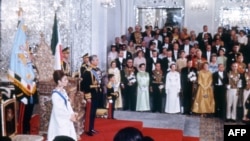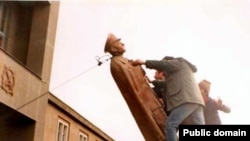Prince Reza Pahlavi has called for "civil disobedience" and an "all out reconstruction" of Iran in a message addressing young Iranians on the occasion of the 40th anniversary of the Islamic revolution that toppled monarchy in Iran in 1979.
In the message widely published on social media, Prince Reza, the heir to the last Shah of Iran before the revolution, said that "civil disobedience is the first step toward the reconstruction of Iran."
He added figuratively that after forty years of "imprisonment of Iran," the country's reconstruction is a "new choice" for Iranians.
Reza Pahlavi's name has been frequently in the news about Iran since late 2017 and early 2018 when large groups of Iranians particularly in the religious cities of Qom and Mashad, called for the return of monarchy during nationwide demonstrations fuelled by political dissent and a deep economic crisis.
In recent months the prince has been more outspoken, calling for a stronger push to dismantle the Islamic republic.
Meanwhile, every February, the anniversary of the Islamic revolution becomes reminiscent of monarchy and revives nostalgia for the modern Iran that existed before the revolution as foreign-based satellite TV channels as well as Iran's state-run television air footage of the Shah and his family. The Iranian media however, spread all sorts of disinformation and misinformation to present a disparaging image of pre-revolution Iran and monarchy.
However, the naïve propaganda campaign often works against the clerical rule as people realize that it has ruined the socio-economic achievements of Iran's previous political system, particularly during recent year as Iran has increasingly plunged into a political and economic crisis with no end in sight.
Prince Reza said in his message: "The current crisis provides an opportunity for the reconstruction of the country located at the crossroads of civilizations. The reconstruction requires a new choice to be made by the younger generation of Iranians who shoulder the burden of responsibility for the reconstruction."
He introduced his choice as "toppling the religious regime," adding that "in the path ahead…an Iranian government is the anti-thesis of the current Islamic government," with the objective of "reconstructing the Iranian civilization in the heart of the geography of tomorrow's world."
"The way out of this crisis is forming a force based on an Iranian discourse; a discourse for reconstruction of Iran in the interest of Iranians' welfare," Prince Reza added, stressing that "after toppling the Islamic Republic of Iran, it is time to reconstruct Iran and its national identity."
Referring to last year's nationwide anti-government demonstrations, he said, "The first step in this path is reconstructing the Iranian civilization on the ruins of a rigid fundamentalism," adding that "The highest outcome of the revival of Iranian civilization is forming a national government. However, managing the transition from the current situation to a national government is a role more essential and significant than ever."
Calling on young Iranians to "intelligently topple those who are against Iran," Prince Reza promised: "I will always stand next to you and those who will build the great Iran of tomorrow."
Protest demonstrations swept across over 100 Iranian cities last year and was followed during the year by continuous, but otherwise smaller protests all over the country by women, religious minorities, workers, farmers, teachers and other groups demanding social, political and economic justice, an end to systematic corruption and discrimination and wasting the country's resources for the ruling clerics' regional ambitions in Syria and elsewhere in the Middle East and North Africa.
Meanwhile, as living conditions have increasingly worsened during in the past one year, those who still remember the pre-1979 era have been reflecting about the state of welfare in Iran under the Shah, sometimes glamorizing it with a bit of exaggeration. A conservative politician said last year that unlike other languages, Persian, the language spoken in Iran, has four tenses: The past, the present, the future, and the Shah's time.







